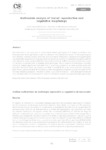Please use this identifier to cite or link to this item:
http://www.alice.cnptia.embrapa.br/alice/handle/doc/1057376| Title: | Multivariate analysis of 'bacuri' reproductive and vegetative morphology. |
| Authors: | SOUZA, I. G. de B.  SOUZA, V. A. B. de   SILVA, K. J. D. e   LIMA, P. S. da C.   |
| Affiliation: | ISIS GOMES DE BRITO SOUZA, UFPI; VALDOMIRO AURÉLIO BARBOSA DE SOUZA, CPAMN; KAESEL JACKSON DAMASCENO E SILVA, CPAMN; PAULO SARMANHO DA COSTA LIMA, CPAMN. |
| Date Issued: | 2016 |
| Citation: | Comunicata Scientiae, v. 7, n. 2, p. 232-240, 2016. |
| Description: | The objective of this study was to characterize sixteen genotypes of P. insignis available in the Embrapa Meio-Norte germplasm collection (Teresina, Piauí, Brazil) with respect to 33 morphological traits relating to leaves, flowers, branches, fruits and seeds. Phenotypic variance among genotypes was estimated using the Mahalanobis distance technique and the unweighted pair group method with arithmetic mean analysis (UPGMA). The method of Singh (1981) was used to determine which of the traits contributed most to diversity within genotypes. The occurrence of phenotypic variability among P. insignis genotypes indicated that it would be possible to achieve positive gains with selection. The most distant genotypes were BGB 16 and BGB 48, while crosses between genotype BGB 48 and genotypes BGB 32 and BGB 56 offers the greatest potential as parental types for this fruit tree breeding programs . The flesh content, ovary and fruit length , ratio between fruit length and diameter were the characters that most contributed to diversity among the studied genotypes. |
| Thesagro: | Platonia Insignis |
| Keywords: | Diversidade fenotípica Distância de Mahalanobis |
| DOI: | 10.14295/CS.v7i2.779 |
| Type of Material: | Artigo de periódico |
| Access: | openAccess |
| Appears in Collections: | Artigo em periódico indexado (CPAMN)  |
Files in This Item:
| File | Description | Size | Format | |
|---|---|---|---|---|
| ArtigoSarmanhoComunicata2016.pdf | 472,74 kB | Adobe PDF |  View/Open |









